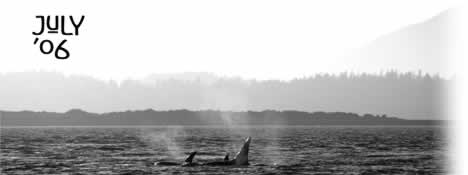
The Wild Garden
by Dan Harrison, Tofino

A few times every winter we experience the shock of an electrical blackout. First the candles come out, then the playing cards. An hour later you find yourself 20 people back in the Common Loaf line-up. The candles flicker softly on the counter, coffee is brewing on the gas burner, and the bidding for day-olds begins. It doesn't take long to feel the dependency of the Co-op pulling on your growling stomach. Only these few days a year are we reminded of our remote domain; a glimpse into pre-contact dimensions of no electricity and more importantly, no imported foods.In the late 1800s imported food arrived in Tofino via the Maude, Willapa, Queen City and the Tees, a patchwork fleet of steamships that began the first means of consistent food supply to the region. About one hundred years later, bidding for day-olds at the Common Loaf, it's very clear how imported food has become a lifeline.
But what about the previous ten thousand years? Local knowledge and archeological finds indicate that people have inhabited this area for as long as ten thousand years. Yes, that means ten thousand years without a grocery store. This is evidence enough that the ocean and the rainforest can provide us with more than enough to simply get by.
While birds, mammals, fish and shellfish formed the bulk of the First Peoples' diet, there is no denying the nutritional importance plant foods had in supplementing this mainly carnivorous fare. While some plants in our rainforest have toxic properties, it takes only the slightest curiosity to learn which plants can be eaten and which ones should be avoided. There are many field guides that can help you in discovering this wild garden, such as "Food Plants of Coastal First Peoples" by Nancy Turner and "Plants of Coastal British Columbia" by Jim Pojar and Andy Mackinnon, to name a few. Harvesting of wild plants can be done at many different times of year, understanding what to harvest when is something you will only begin to understand with experience. Some of the tastiest and easiest food plants to harvest are berries. Berries can be harvested in the early summer and well into the late fall/winter. While there are well over 35 edible native berries in and around Clayoquot Sound, below is an abbreviated field guide to give you a taste of what's out there.
Salmonberries
(Rubus spectabilis)One of the earliest ripening berries of the region; salmonberries will begin to catch your eye as early as May. The small, pink flowers of the salmonberry bush are a harbinger of spring, and signal that these juicy berries are on their way. The three leaflets resemble a raspberry bush, as do the berries, which range from pink to orange to red.
Thimbleberries
(Rubus parviflorus)
Thimbleberries ripen slightly after salmonberries in the early summer. The large, white flowers and soft, maple leaf-like leaves will help you identify this bush. The berries are some of the sweetest of the native berries, resembling small raspberries, but not as juicy. It is believed that thimbleberries are the only berry besides salal berries that were dried by the Nuu-chah-nulth.
Salal Berries
(Gaultheria Shallon)
It's nearly impossible to wander in the rainforest during the summer months without being cornered by salal berries. Salal is the dominant understory plant of our coastal rainforest and can be identified by its waxy, evergreen leaves and dark-blue berries. The berries are much fleshier than other berries, which allows them to 'keep' longer than juicy berries. Salal berries were an important food source amongst Nuu-chah-nulth peoples, due to their abundance, as well as the ability to dry berry clusters into cakes to be eaten over winter.
Evergreen Huckleberries
(Vaccinium ovatum)
Evergreen huckleberries are the late bloomers of the summer berry explosion. Found in tight clusters along branches of this 1 to 2 metre shrub, evergreen huckleberries are small and ripen from red to black in the late summer. They are valued as a hearty winter berry, for if left unpicked they will remain edible well into the late autumn and winter. Rumour has it that they are at their very best following the first frost. The small, green, sharp-toothed, waxy leaves along its branches help to easily identify this shrub.
These four delicious berries can be found in abundance throughout our rainforest. But be careful, make sure you know what you are harvesting as it might save your life. Also, keep in mind that many animals rely on berries as a food source, so please harvest in moderation.
By Dan Harrison, Summer Interpreter, Raincoast Interpretive Centre
tofino | tofino time | activities | accommodation | events | directory
maps | travel | food | art & artists | photos | horoscope | tides
search | magazine | issues | articles | advertising | contact us
hosted in tofino by tofino.net & studio tofino
© 2002-2014 copyright Tofino Time Magazine in Tofino Canada
